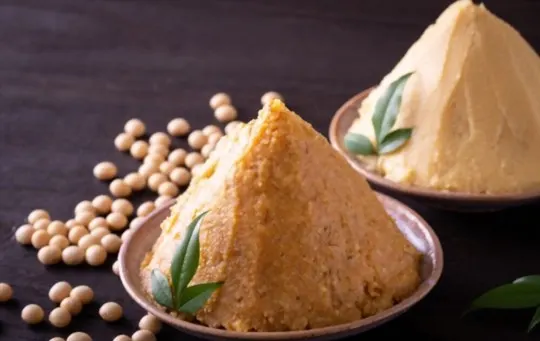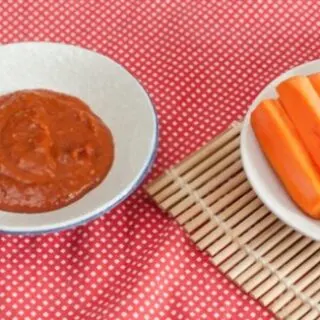Ssamjang is a Korean condiment made with a combination of gochujang and doenjang, two Korean staples that are common in many traditional Korean recipes.
It has a spicy flavor with a slight sweetness, making it ideal for adding flavor to meats, vegetables, and even soups.
If you’re looking for something to add a bit of kick to your meals or need an alternative to ssamjang, there are several great substitutes available.
In this article we’ll take a look at some of the most popular options and discuss how they can help turn your meal from ordinary into extraordinary.
What is Ssamjang?

Ssamjang is a type of thick, spicy dipping sauce that is popular in Korean cuisine.
It is traditionally made from doenjang (soybean paste), gochujang (red pepper paste), garlic, sesame oil, and scallions.
It is commonly used for dipping vegetables into when eating barbecue and hot pot dishes, as well as for flavoring a variety of other side dishes.
With its unique flavor that combines salty, sweet and spicy elements, Ssamjang has become an iconic flavor in Korea that can be used to create an interesting depth of flavor to many different types of food.
How to Cook and Use Ssamjang?
Ssamjang is an extremely popular Korean condiment that is a delicious addition to many recipes.
It has some similar flavors to gochujang, but it’s a bit more mild, making it a nice middle ground between gochujang and sesame oil as far as spiciness and flavor are concerned.
Ssamjang is a combination of doenjang (Korean fermented bean paste), spicy red pepper paste (gochujang), garlic, sesame oil, scallions, and sometimes honey or sugar.
It’s used primarily for dipping vegetables and meats into before eating them Korean-style.
It can be used in recipes where you’d like to give an added depth of flavor and spice.
Some dishes where you can use ssamjang are marinades, vegetable side dishes, stir-fries, grilled or sautéed meats and fish or on top of fried eggs.
You can also make your own ssamjang by combining equal amounts of doenjang (Korean fermented bean paste) with gochujang (spicy red pepper paste).
Using ssamjang is fairly easy.
If you’re just using it for dipping sauces then simply mix all the ingredients together in a bowl.
If using it in cooking then add it at the end of the cooking process so that the flavors don’t get cooked out.
You can adjust the amount of doenjang and gochujang depending on how intense you want the flavors to be — usually about 2 parts doenjang to one part gochujang is what most Koreans tend to use when making their own version at home.
5 Best Ssamjang Substitutes to Consider
Ssamjang is typically served alongside barbecue dishes such as grilled pork or beef, lettuce wraps and more.
If you’re unable to find ssamjang at your local grocery store or if you’re looking to try a different flavor, there are five excellent substitutes worth considering:
1 – Gochujang

Gochujang is often used as an alternative to ssamjang because it has the same pungent taste and thick texture.
It’s made with fermented soybeans, glutinous rice, chili peppers, and other seasonings.
Its flavor profile has the combination of sweet, spicy and salty flavors.
Gochujang goes great with grilled meats like bulgogi or bibimbap, finished off with a bit of cooked white rice or bean thread noodles.
While some brands do contain a bit of fish sauce and shrimp extract, there are many that are vegan-friendly so be sure to check the ingredients list before you buy.
2 – Doenjang

Doenjang is perhaps the closest substitute for ssamjang, as it has a similar texture and flavor.
Doenjang is a fermented soybean paste from Korea, made by fermenting boiled soybeans and salt together.
It is usually sold in either tubs or jars, depending on the brand.
Doenjang has a deeper, earthier flavor than other condiments used for ssamjang recipes such as gochujang — and it also carries more umami flavor.
While doenjang does contain some gochujang for heat, it may not be spicy enough to satisfy everyone’s taste.
Therefore, if you wish to recreate an authentic ssamjang flavour, it’s best to use some gochujang as well — but this may not be necessary depending on personal preferences.
3 – Sambal Oelek

Sambal Oelek is a traditional Indonesian chili paste made from ground chilies and other ingredients like garlic, shallots, ginger and sometimes vinegar.
Like ssamjang, sambal oelek is spicy but without the added sweetness.
It’s also thick enough to provide some structure in the dish.
Sambal oelek works best in dishes that don’t call for a complex flavor profile.
Use it as a condiment on meats or vegetables, or as an ingredient in dipping sauces and marinades to add texture and heat, while still keeping the overall flavor of your dish relatively simple.
4 – Chili Garlic Paste with Sesame Oil

Chili garlic paste with sesame oil is another option to substitute for ssamjang, and it’s a terrific way to add heat and flavor to a variety of Asian dishes.
You can find chili garlic paste at most grocery stores, or you can make your own at home by mixing equal parts minced garlic and red chiles with a bit of oil.
For added flavor, you can also add some sugar, soy sauce, rice vinegar or even hoisin sauce.
Once combined, mix in some sesame oil until the desired taste is achieved.
This unique mixture will add a spicy kick to any dish and it pairs particularly well with grilled meats or vegetables.
5 – Miso Paste with Sesame Oil

Miso paste is a Japanese condiment, made from fermented soybeans and other ingredients.
It has an umami flavor that combines salty and sweet notes.
When combined with sesame oil, it can be used as an excellent substitution for Ssamjang, offering an earthy and very mildly spicy flavor.
To prepare it as a substitute for Ssamjang, mix together 2 teaspoons of white or red miso paste with ¼ teaspoon sesame oil.
Alternatively, you could use Miso paste alone as the richness of its flavor will provide a great substutite alternative to ssamjang.
Conclusion
Ssamjang, an essential Korean condiment, is the perfect accompaniment to countless Korean dishes.
This thick and spicy paste adds a kick of heat and umami to your meal, though it might be hard to find in some places.
Thankfully, there are plenty of ssamjang substitutes that still bring bold flavor to your favorite recipes.
Soybean pastes like doenjang and gochujang can be readily found in most markets or online.
To add a tad more texture to your dishes, try nutty tahini or complex miso.
Or if you’re looking for a milder alternative with slightly sweet notes, substitute ssamjang with kecap manis or even barbecue sauce for an easy at-home approach.
Whichever route you decide to take, these substitutes provide great alternatives for adding a unique zip into your creations.
Frequently Asked Questions
What is Ssamjang?
Ssamjang is a Korean condiment that is a spicy and savory mixture of gochujang, doenjang, sesame oil, garlic, and green onions.
It is typically served with a variety of meats, vegetables, and other Korean dishes.
What are the 5 best substitutes for Ssamjang?
The 5 best substitutes for Ssamjang are: 1) gochujang and doenjang combined, 2) chili garlic sauce, 3) harissa, 4) hoisin sauce, and 5) miso paste.
How do you make Ssamjang?
To make Ssamjang, you will need gochujang, doenjang, sesame oil, garlic, and green onions.
Combine all of the ingredients together in a bowl and mix until fully combined.
Enjoy your homemade Ssamjang.

5 Best Ssamjang Substitutes to Consider
Ingredients
- 1 – Gochujang
- 2 – Doenjang
- 3 – Sambal Oelek
- 4 – Chili Garlic Paste with Sesame Oil
- 5 – Miso Paste with Sesame Oil
Instructions
- Choose your preferred substitute from the list of options.
- Organize all of your ingredients.
- Use the proper substitute to cook your recipes.

Carrie is a food writer and editor with more than 15 years of experience. She has worked for some of the biggest names in the food industry, including Bon Appétit, Food & Wine, and Martha Stewart Living.
As the Editor in Chief of IntroChicago.com, Carrie oversees all of the content on the site. She also manages the team of contributing writers and editors, who help to create delicious recipes, helpful tips, and informative articles that you’ll find on the site.
A native of the Chicago area, Carrie is passionate about all things food. She loves trying new restaurants and experimenting with new recipes in her kitchen. She’s also a graduate of the Culinary Institute of America, so she knows a thing or two about food!
